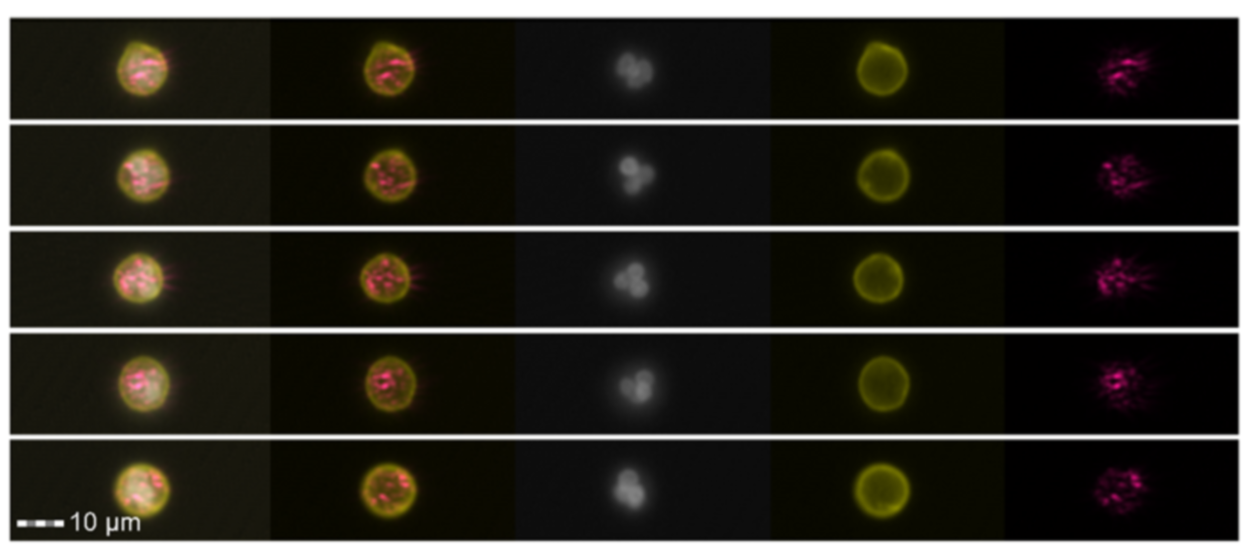Multiscale Profiling of Nanoscale Metal-Organic Framework Biocompatibility and Immune Interactions. Zhuang Y, Mendes BB, Menon D, Oliveira J, Chen X, Duman FD, Conniot J, Mercado S, Liu X, Zhang SY, Conde J, Hewitt RE, Fairen-Jimenez D. Adv Healthc Mater. 2025 Aug 7:e01809. https://doi.org/10.1002/adhm.202501809
Immunocompetent cell targeting by food-additive titanium dioxide. Wills JW, Dabrowska A, Robertson J, Miniter M, Riedle S, Summers HD, Hewitt RE, Fathima A, da Silva AB, Bastos CAP, Micklethwaite S, Keita ÅV, Söderholm JD, Roy NC, Otter D, Jugdaohsingh R, Mastroeni P, Brown AP, Rees P, Powell JJ. Nat Commun. 2025 Jul 4;16(1):6067. https://doi.org/10.1038/s41467-025-60248-9
Editorial: Modulation of the immune system by nanoparticles. Hewitt RE, De Marzi MC, Ng KW. Front Immunol. 2023 Apr 11;14:1190966. doi: 10.3389/fimmu.2023.1190966.
Label-Free Identification of Persistent Particles in Association with Primary Immune Cells by Imaging Flow Cytometry. Vis B, Powell JJ, Hewitt RE. Methods Mol Biol. 2023;2635:135-148. doi: 10.1007/978-1-0716-3020-4_8.
Formulation of Metal-Organic Framework-Based Drug Carriers by Controlled Coordination of Methoxy PEG Phosphate: Boosting Colloidal Stability and Redispersibility. Chen X, Zhuang Y, Rampal N, Hewitt R, Divitini G, O'Keefe CA, Liu X, Whitaker DJ, Wills JW, Jugdaohsingh R, Powell JJ, Yu H, Grey CP, Scherman OA, Fairen-Jimenez D. J Am Chem Soc. 2021 Sep 1;143(34):13557-13572. doi: 10.1021/jacs.1c03943.
Small and dangerous? Potential toxicity mechanisms of common exposure particles and nanoparticles. Hewitt RE, Chappell HF, Powell JJ. Curr Opin Toxicol. 2020 Feb;19:93-98. doi: 10.1016/j.cotox.2020.01.006.
Ultrasmall silica nanoparticles directly ligate the T cell receptor complex. Vis B, Hewitt RE, Monie TP, Fairbairn C, Turner SD, Kinrade SD, Powell JJ. Proc Natl Acad Sci U S A. 2020 Jan 7;117(1):285-291. doi: 10.1021/acsnano.8b03363
Imaging flow cytometry methods for quantitative analysis of label-free crystalline silica particle interactions with immune cells. Vis B, Powell JJ, Hewitt RE. AIMS Biophys. 2020;7(3):144-166. doi: 10.3934/biophy.2020012
Non-Functionalized Ultrasmall Silica Nanoparticles Directly and Size-Selectively Activate T Cells. Vis B, Hewitt RE, Faria N, Bastos C, Chappell H, Pele L, Jugdaohsingh R, Kinrade SD, Powell JJ. ACS Nano. 2018 Nov 27;12(11):10843-10854. doi: 10.1021/acsnano.8b03363.
Imaging flow cytometry assays for quantifying pigment grade titanium dioxide particle internalization and interactions with immune cells in whole blood. Hewitt RE, Vis B, Pele LC, Faria N, Powell JJ. Cytometry A. 2017 Oct;91(10):1009-1020. doi: 10.1002/cyto.a.23245
Reduction of T-Helper Cell Responses to Recall Antigen Mediated by Codelivery with Peptidoglycan via the Intestinal Nanomineral-Antigen Pathway. Hewitt RE, Robertson J, Haas CT, Pele LC, Powell JJ. Front Immunol. 2017 Mar 17;8:284. doi: 10.3389/fimmu.2017.00284
Synthetic mimetics of the endogenous gastrointestinal nanomineral: Silent constructs that trap macromolecules for intracellular delivery. Pele LC, Haas CT, Hewitt RE, Robertson J, Skepper J, Brown A, Hernandez-Garrido JC, Midgley PA, Faria N, Chappell H, Powell JJ. Nanomedicine. 2017 Feb;13(2):619-630. doi: 10.1016/j.nano.2016.07.008
An endogenous nanomineral chaperones luminal antigen and peptidoglycan to intestinal immune cells. Powell JJ, Thomas-McKay E, Thoree V, Robertson J, Hewitt RE, Skepper JN, Brown A, Hernandez-Garrido JC, Midgley PA, Gomez-Morilla I, Grime GW, Kirkby KJ, Mabbott NA, Donaldson DS, Williams IR, Rios D, Girardin SE, Haas CT, Bruggraber SF, Laman JD, Tanriver Y, Lombardi G, Lechler R, Thompson RP, Pele LC. Nat Nanotechnol. 2015 Apr;10(4):361-9. doi: 10.1038/nnano.2015.19
Immuno-inhibitory PD-L1 can be induced by a peptidoglycan/NOD2 mediated pathway in primary monocytic cells and is deficient in Crohn's patients with homozygous NOD2 mutations. Hewitt RE, Pele LC, Tremelling M, Metz A, Parkes M, Powell JJ. Clin Immunol. 2012 May;143(2):162-9. doi: 10.1016/j.clim.2012.01.016
MHC class I molecules with Superenhanced CD8 binding properties bypass the requirement for cognate TCR recognition and nonspecifically activate CTLs. Wooldridge L, Clement M, Lissina A, Edwards ES, Ladell K, Ekeruche J, Hewitt RE, Laugel B, Gostick E, Cole DK, Debets R, Berrevoets C, Miles JJ, Burrows SR, Price DA, Sewell AK. J Immunol. 2010 Apr 1;184(7):3357-66. doi: 10.4049/jimmunol.0902398


